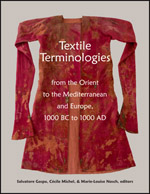Center, Textile Research

Textile Terminologies from the Orient to the Mediterranean and Europe, 1000 BC to 1000 AD
Date of this Version
2017
Document Type
Article
Citation
In Textile Terminologies from the Orient to the Mediterranean and Europe, 1000 BC to 1000 AD, ed. Salvatore Gaspa, Cécile Michel, & Marie-Louise Nosch (Lincoln, NE: Zea Books, 2017), pp. 295-300.
doi:10.13014/K25T3HNR
Abstract
With regard to ancient textile terms, dictionaries could potentially generate a false sense of security. Their formal accuracy might let us think that we are, without doubt, provided with the term that corresponds perfectly with a particular expression from an ancient Greek and/or Latin document. However, translations in dictionaries are almost exclusively based on reading and interpreting ancient literary sources and tend to neglect documentary evidence. But documentary sources, such as papyri, are a valuable and unique resource for research, referring to manifold aspects of social and economic history. Above all, they offer an insight into the minutae of individual lives, an aspect of ancient history that is rarely available to current research. These kinds of sources significantly deepen the understanding of the ancient world – compared to information retrieved only from literary sources. The present contribution derives from a research project made possible by the Pasold Research Fund.1 It focuses on ancient marriage documents from the province of Egypt with its abundance of papyrological evidence as a case study on the terminology of everyday dress in Roman Imperial times.
Source material: Dowry contracts from Roman Egypt -- Before paper and parchment were common writing materials, people used wooden tablets, papyri or potsherds (ostraca) for private correspondence as well as for official documents. Especially the abundance of papyri and ostraca broadens our perspective on antiquity from literary sources. Mainly originating from Egypt, these documents provide a direct and unfiltered view of real life circumstances for all classes of population in this region.2 After Alexander III (‘the Great’) had conquered Egypt and introduced the Greek language in this part of the Mediterranean in 332 BC, it was used for official documents. Until the Arab invasion in 640-642 AD, the Greek language also played an important role in private correspondence. Thus most papyri and ostraca were written in Greek. The majority of Greek papyri and ostraca date back to the first three centuries AD, when Egypt was a province of the Roman Empire. They consist of a variety of documents – works of literature, letters, horoscopes, accounts, receipts, tax registers, declarations, contracts, and more. Making the individual tangible, they let us explore an ‘individual micro-history’ and bring administrative trading records to life. Their evidence provides an unfiltered view of real-life circumstances of all population classes. With regard to the economic procedures of Roman textile production, they allow for a more detailed analysis. Marriage and dowry arrangements are of particular value for research on female dress of the Roman period. “One of the main purposes for the composition of a marriage document was to record the delivery of a dowry, its value and contents, and to regulate its position both in the course of the marriage and after its dissolution.”3 The detailed description of every item of the dowry was very important because, in case of divorce, it enabled the woman to enforce her right of regaining this dowry within a short time. However, some contracts record the overall value of the dowry rather than its original components. In these cases, which mostly date back to Augustean times, the husband could possibly dispose of dowry components without any special restraints as long as he was still capable of returning the total value. However, in later marriage documents the components are usually listed in great detail. A typical dowry from the first three centuries AD in Roman Egypt usually includes clothing, along with cash instalments, jewellery and household implements. The typically high level of detail offers a unique chance to learn about women’s garments which were actually worn in everyday life in this part of the Roman Empire. We can discover details about the terminology of female garments, their colours and sometimes even the value of an actual garment.
Included in
Ancient History, Greek and Roman through Late Antiquity Commons, Art and Materials Conservation Commons, Classical Archaeology and Art History Commons, Classical Literature and Philology Commons, Fiber, Textile, and Weaving Arts Commons, Indo-European Linguistics and Philology Commons, Jewish Studies Commons, Museum Studies Commons, Near Eastern Languages and Societies Commons, Other History of Art, Architecture, and Archaeology Commons


Comments
Copyright © 2017 Salvatore Gaspa, Cécile Michel, & Marie-Louise Nosch. Photographs copyright as noted.